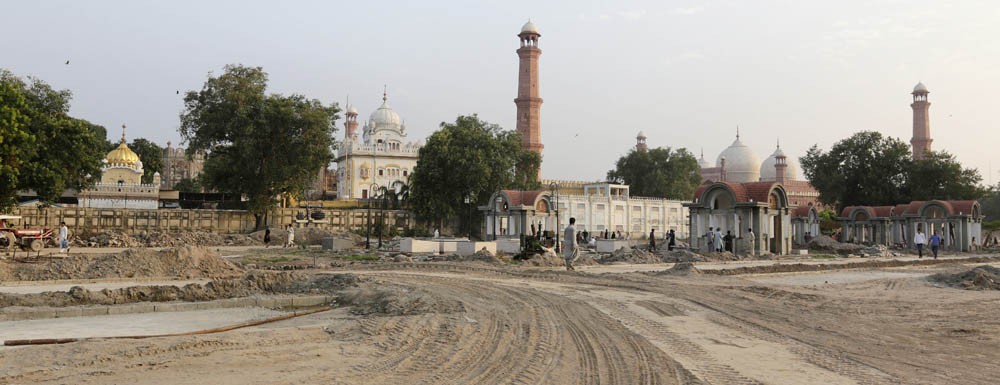
The on-going expansion and renovation of Iqbal Park, undertaken by the Punjab government, has the residents of the Walled City becoming edgy

Greater Iqbal Park, as we know it today, has a history dating back to the eighteenth century. Back then, it was a huge fruit orchard with open green spaces.
From being a fruit garden in the Mughal era to a parade ground in the Sikh period to Minto Park in the British rule and Iqbal Park, following the construction of the Pakistan Monument aka Minar-e-Pakistan, this historic piece of land has been altered and rechristened many times over in the past three centuries.
The on-going expansion and renovation project undertaken by the Punjab government is the most recent change in its landscape. Both the government officials and the residents of the Walled City -- home to Iqbal Park -- have different perspectives on the expansion project.
Where the government is calling it an initiative meant to preserve the heritage sites of national import, the locals see it as an encroachment on spaces dear to them.
The other major point of difference is related to the way ‘recreational’ is being defined.
A look at the statistics may help in explaining these differences. Official sources claim that the area of Iqbal Park was originally spread over 61.88 acres. Post-expansion, it is going to be 117 acres (approx.). That means an addition of 54.81 acres, which includes the area where the locals would get together and picnic, and the young would play as it had a cricket ground, a hockey and football stadium, and an akhaara (desi gym). The common people would also use the ground to fly kites. Hence, it was often called Guddi Ground.
The Greater Iqbal Park project, still underway even though it was earlier supposed to be inaugurated on August 14 this year, includes the area between the park and Lahore Fort as well as the Guddi Ground or Minto Park. The locals expect things to turn grim for them as they are being deprived of the area that served as their beloved venue for little cultural activities such as poetry recitation sessions. Why tourism should be promoted at the cost of the locals’ recreation, they ask.
Shoaib Ahmad, a resident of Qila Lachman Singh, who now plies a rickshaw, grew up playing cricket in the park. He recalls, "People used to come here and play all sorts of games including cricket, hockey and kite-flying. There was also an akhaara that hosted competitions on weekly basis, attracting hordes of people from adjoining areas.
"Many great wrestlers, cricketers and other sportsmen of the country played here," he says.
Defending the government’s stance, Project Director, Horticulture Akhtar Mehmood says seven acres of land were allotted in Qila Lachman Singh to create an alternative space for the sports ground in Iqbal Park. "We’ve also allocated a piece of land for an akhaara within the park. It will be an improved version of the [previous] facility," he tells TNS.
When asked if seven acres in exchange of 55 acres was an agreeable proportion, he says, "The government plans to relocate the Lorry Adda and Sabzi Mandi to make further room for sports grounds for the residents of the densely populated Walled City."
Tahir Sultan, Project Director, Engineering Works, insists the intention is "to make Minar-e-Pakistan an even more attractive tourist destination.
"The Greater Iqbal Park is supposed to represent the diversity of the federating units of Pakistan," he declares.
Sultan also speaks of setting up a museum that will depict the various aspects of cultural history. Yet another important feature of the project is the dancing fountain which is being installed in collaboration with a Chinese company. A lake, an amphitheatre, memorials representing all the four provinces of the country, ceremonial gates, two food courts, a bughi track, a soft-wheel train, four rotundas, five souvenir kiosks, two-deck fountains, car parking areas, and cafeterias are also part of the Greater Iqbal Park.
Explaining why the project inauguration was postponed, Sultan says it was "due to rains and the intricate nature of work.
"The project may be inaugurated on any other day of national importance once it is complete -- perhaps, November 9 or December 25."
Critics of the project believe the two things the Walled City residents were proud of -- the Ravi River and Minto Park -- are both being destroyed. The river has been turned into a drainage channel and the park, a heritage site, has been subsumed under a vaguely defined project.
Noted artist Ajaz Anwar says, "I have visited the place recently. This [Greater Iqbal Park] is a large-scale intervention which I think should have been avoided.
"Minto Park was of great cultural significance for the people of the Walled City. They have been deprived of their heritage. Lots of trees have been felled, birds and squirrels have migrated, Attiq Stadium has been demolished. Besides, structures have been put up that obstruct the view of the Badshahi Masjid."
He also comes down hard on the government for wanting to "build a lake there; it’s not a good idea when you have archaeological sites in the vicinity. Governments all over the world give primary importance to such sites but we do not seem to care for them."
One common objection with regards to the project is the official preference for development projects that involves bringing heavy construction machinery out there. "The government should instead focus on the existing few sports facilities," says Rahat Ali, an angry resident of Bhatti Gate. "The Walled City people are upset because they feel they have been left out and are underrepresented in designing the project."